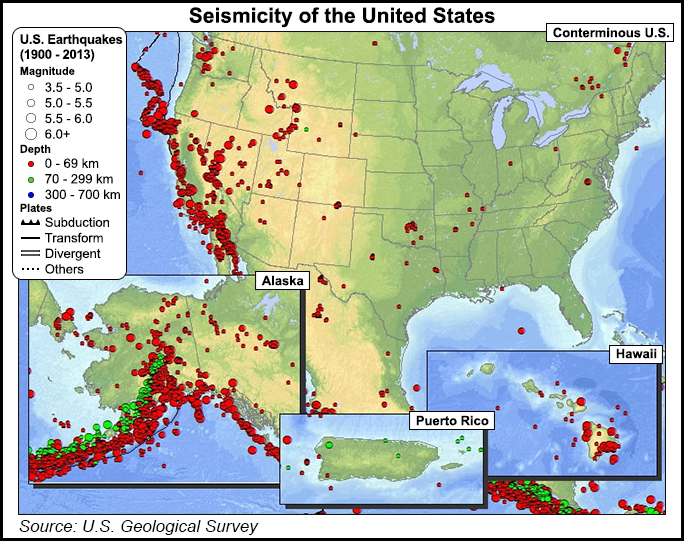USGS Wants More Frequent Earthquake Studies
The U.S. Geological Survey (USGS), which has traditionally assessed seismic risks on a six-year schedule, is proposing an annual hazard model to more effectively predict earthquakes.

“It is clear that the established, six-year update schedule for the NSHM [National Seismic Hazard Model] is not ideal to address induced seismicity,” USGS said in a report released Thursday. “Annual or even more frequent updates of the hazard model and other products could account for rapid changes in induced seismicity.”
About 150 participants in a November 2014 workshop hosted by USGS and the Oklahoma Geological Survey (OGS) “agreed that creating a short-term (for example, one year) hazard model that incorporates induced seismicity would be beneficial,” USGS said.
Earthquake activity in the central and eastern United States has sharply increased since 2009, and “the increase has been linked to industrial operations that dispose of wastewater by injecting it into deep wells,” the agency said.
The report outlines a preliminary set of models to forecast how hazardous tremors could be in areas where sharp increases in seismicity have been recorded. It also identifies issues that must be resolved to develop a final hazard model, which is scheduled for release at the end of the year. “These preliminary models should be considered experimental in nature and should not be used for decision-making,” USGS said.
Last year, USGS scientists speculated that the extreme increase in seismic activity in Oklahoma in recent years was probably linked to wastewater injections as part of the oil/gas drilling processes (see Shale Daily, July 15, 2014; March 10, 2014). With growing concerns about seismic activity tied to oil and natural gas operations in the state, USGS deployed two seismic monitors to Cushing, OK, after a swarm of earthquakes near the crude storage/transportation center (see Shale Daily, Oct. 15, 2014).
“Many questions have been raised about whether hydraulic fracturing — commonly referred to as ”fracking’ — is responsible for the recent increase of earthquakes,” USGS said. “USGS’s studies suggest that the actual hydraulic fracturing process is only occasionally the direct cause of felt earthquakes.”
The NSHM considers where future earthquakes will occur, how often they will occur, and how strong the quakes will be, based largely on data about previous earthquakes.
“Modeling induced seismicity in probabilistic seismic hazard analysis is very difficult, since we do not understand some of the fundamental differences between natural and induced earthquakes, and because the seismic activity can change based on changes in human activity,” USGS said. “Predicting when and where induced seismicity will occur in the future is challenging. For example, induced seismicity does not occur near every disposal well, so it is important that we continue to study and learn more about how these earthquakes are generated, so we can better assess future patterns and trends.
“In Oklahoma, activity rates have varied exponentially, and earthquakes have migrated several tens of kilometers over a year or two. These changes may be related to oil and gas exploration activity, but they also may depend on physical processes, which are poorly understood.”
The suggested changes for the NSHM come on the heels of a report from OGS that concluded that disposal wells and the large amounts of produced water they handle from oil and gas operations are “very likely” the culprit for numerous earthquakes to strike Oklahoma (see Shale Daily, April 22). And seismologists at Southern Methodist University said Tuesday that high volumes of wastewater injection combined with saltwater extraction from natural gas wells is the “most likely cause” of earthquakes occurring near the Barnett Shale town of Azle, TX, in 2013 and 2014 (see Shale Daily, April 21).
© 2024 Natural Gas Intelligence. All rights reserved.
ISSN © 2577-9877 | ISSN © 2158-8023 |
